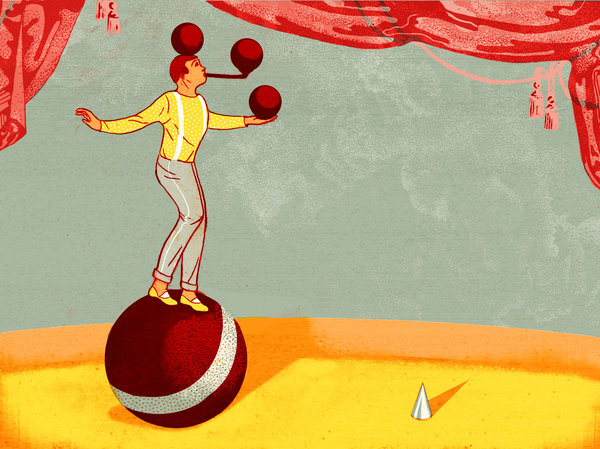“Circus shows self-management, perfection of physical strength and human power over animals. Circus – it is gestures, posture, activity.”1 /Hugues Hotier/
Risk, Fear, Superman, Control, Effort, Beauty ..
The central concept of circus is the perfection of human power. All circus performances show man’s ability to handle himself or overcome barriers and obstacles in his life. For more than 200 years circus has entertained crowds of people. Why? What attracts us to the circus? It turns out that a number of circus theoreticians have wondered about this issue.
Circus – reflection of values of the western society.
Communication scholar and the author and editor of various publications dedicated to circus, a former circus artist Hugues Hotier says quite simply, “In circus a man to man is no longer a wolf.”2 The man does not fight against others but rather tries to overcome himself. Acrobats, jugglers, strongmen – all these artists give the opportunity to see human capacity development. Clowns in their etudes often face self- made or society-made pullbacks which they have to overcome. Performances with animals show a person’s ability to rule over nature. In his works he also stresses the reflection of western Christian culture values in circus. In Judeo- Christian upbringing, which is representative to our society, the basic values are effort and work. Work – as an investment with a guaranteed refund. Undoubtedly, the perfection which the spectator sees at the arena is a result of great effort and work.3
Circus – the story of monkey becoming a human.
An interesting perspective is offered by a Canadian circus semiotics Paul Bouissac. He associates circus charm with primitive and even prehistoric instincts. In his view, circus artists are not better suited to life as normal persons, but the spectator considers the artists as people who have reached perfection in a very narrow field, as superhumans who are more gifted than others. It’s interesting that circus is built on the most important skills that are necessary to survive – those that we had needed to survive even in times when we lived in trees. Historically, a man had to overcome several obstacles and perform a variety of tasks to survive, such as collect food, hunt, avoid the attackers, reproduce himself. By analyzing all this, it has been discovered that any of these capabilities can be used as the basics of the circus performance. To achieve all this, a man has to have such skills:
1. Keep the balance and move through narrow surfaces;
2. Hang in the air-cling and avoid a deadly fall;
3. Get rid of the obstacles while jumping or climbing;
4. Throw and catch items to reach the goal or keep valuable items as their property;
5. Control animals to get the best out of them or to neutralize predator aggression;
6. Cope with social conflicts.4
These are the six basic skills that were necessary for our ancestors to survive, and they have been developed so far that all subsequent human skills are based on them. All the performances that are found in circus are examples of these skills.
Circus – a magical ritual for modern humans.
Circus has something magical and surreal. French circus historian and researcher Jacob Pascal tells that circus is an opportunity to experience something outside of reality – the world of fantasy and mysticism. In his view, circus for the spectator is the same thing as participating in shamanistic actions for ancient man, or the same as attending religious mystery for medieval people.5 Circus offers fantasy, just like books and films. It offers uncommon and supernatural world, only, unlike the first two, it offers not only to watch or imagine, but to have the chance to be the center of it all.
Text by Māra Pāvula
Illustration by Mayumi Otero
1 Hugues Hotier. Le verbe au cirque. No Jeu : revue de théâtre, n° 28, (3) 1983, p. 40-55. http://id.erudit.org/iderudit/28393ac
2 Hotier, Hugues. Cirque, communication, culture. Bordeaux: Presses Univ de Bordeaux, 1995, p. 147
3 Hotier, Hugues. Cirque, communication, culture. Bordeaux: Presses Univ de Bordeaux, 1995, p. 147
4 Bouissac, Paul. Semiotics at the Circus, p. 177
5 Jacob, Pascal. Le cirque. Voyage sous etoiles, p. 8-30




 Follow
Follow